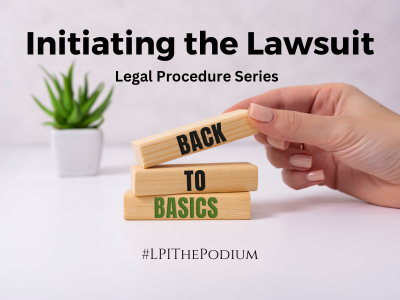
(Part 2 of LPI’s “Back to Basics” Legal Procedures Series)
The civil litigation process begins when a person or entity files a dispute against another person or entity, suing for compensation for damages caused. The judge or jury listening to the case will then apply the appropriate law to the facts presented in court by both parties. The plaintiff files a complaint in court seeking monetary compensation, an injunction, or order as a result of an action by the defendant.
What types of cases do you think of when hearing the term “litigation?” Following are some examples:
Personal Injury (aka “Tort” cases)
Contract Disputes
Class Action Suits
Divorce and Family Law Disputes
Property Disputes
Landlord/Tenant Issues (aka Unlawful Detainer)
Construction Defect
Medical Malpractice
Labor/Employment Issues
Civil Rights
Mechanics Liens
Probate Issues
Conservatorships
That covers a lot, doesn’t it? Fortunately, most of these types of actions all begin the same way – – with the filing of the civil case cover sheet, the summons, and the initial complaint or petition. It has been said that the summons is the “voice of the court,” while the complaint is the “pleading of the party.”
Summons, Complaint, and Civil Case Cover Sheet
The complaint typically identifies the parties, addresses any Doe defendants, identifies the court of jurisdiction, lists the causes of action with allegations to support them, and the relief, legal remedy, or damages sought. The summons tells the defendant that they have been sued, who is suing him/her, what court the lawsuit was filed in, and gives instructions for responding to the lawsuit as well as the consequences of failing to file a response.
The plaintiff must serve the summons and complaint on the defendant(s) within the prescribed time by law (60 days for state court actions) and file the proof of service with the court. The civil case cover sheet is informational and only for the purposes of the court. It does not get served on the defendant(s).
EXHIBITS
Not every complaint will contain exhibits, but if they are to be included, they should be marked as “Exhibit A,” Exhibit B,” etc., and should follow the signature page of the complaint or be prepared as its own document titled “Index of Exhibits.” Regardless of which method is used, California Rules of Court, rule 3.1110(f) requires that an index of exhibits must be included. The exhibits should be separated by slipsheets marked as “Exhibit A,” etc., with the exhibit following the slipsheet if filing electronically. If filing at the court’s counter, bottom exhibit tabs should be used (add slipsheets also for the original).
Electronic exhibits must be bookmarked with links to the first page of each exhibit and include a brief description of the exhibit (Cal. Rules of Court, rule 3.1110(f)(4).)
VERIFICATIONS
While not required for every complaint that gets filed, there are instances where the complaint must include a signed verification statement by the client attesting to the truth of the facts set forth in the complaint. Most petitions are verified and must contain a verification statement. Check with your attorney as to whether you will be filing a verified complaint and will need a signed verification statement from your client.
If it is verified, the plaintiff makes assertions under penalty of perjury. A verified complaint also forces the defendant to respond to the lawsuit with a verified answer. This tactic forces the defendant to immediately make statements about the allegations under oath. There are strategic reasons to use – and not use – a verified complaint when filing a lawsuit.
PETITION
In legal terminology, a petition is made to the court by a petitioner against a respondent, while a complaint is filed by a plaintiff against a defendant. A petition asks the court to provide a court order, while a complaint seeks damages or to force the defendant to start or stop doing something. A petition also may be used to appeal a court’s decision. The petition to appeal states why the legal issues surrounding a case should be reviewed by another court. A summons is generally not required when filing a petition in civil matters.
Because a petition is asking the court for an order, generally a hearing is required to assess the merits of the petition. A notice of hearing with a memorandum of points and authorities in support of the petition, any declarations in support, requests for judicial notice, etc., should be filed with the court and served on all parties once the petition has been filed and hearing date obtained from the court. Opposition responses are due no later than 14 days before the hearing, and replies are due five days before the hearing.
In Part 3 of the “Back to Basics” Legal Procedures Series, we will cover Service of Process, Proofs of Service, and Defending the Lawsuit.
Categorized in: Legal Procedure
| << previous | next >> |








